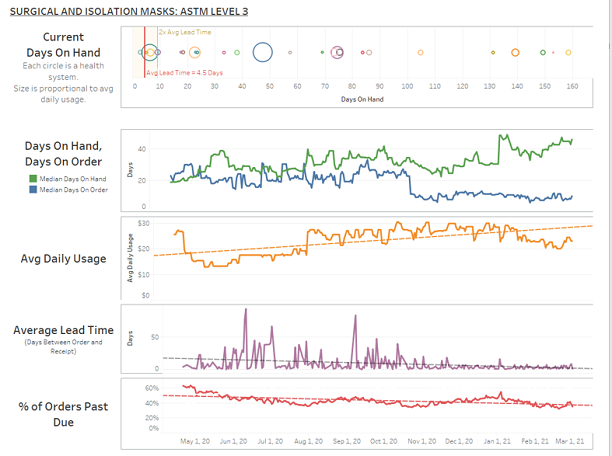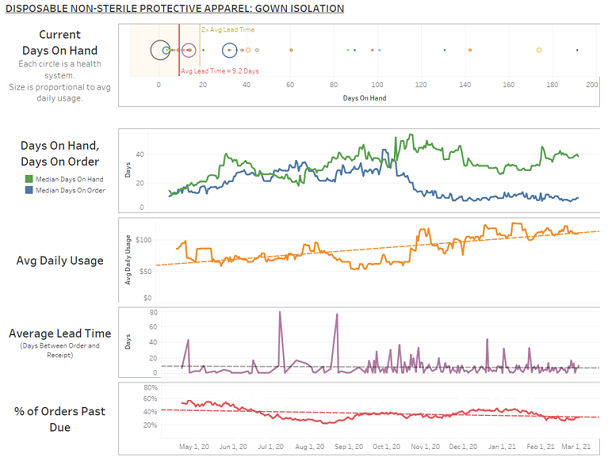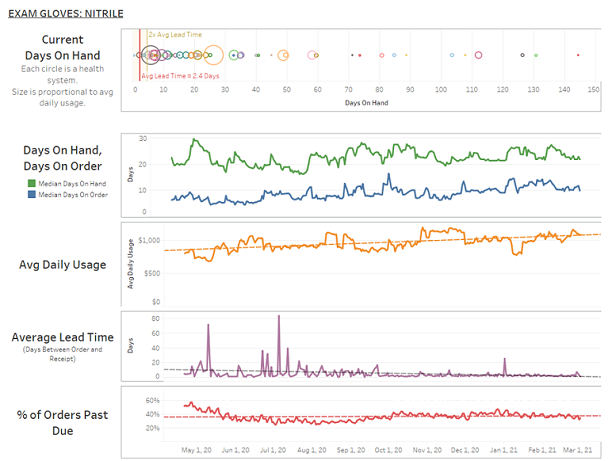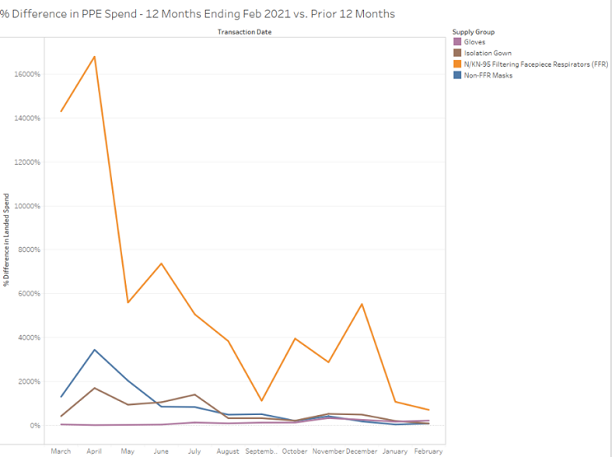A longtime leader in healthcare improvement, we’re developing new ways to revolutionize the industry.

Premier Data: The State of PPE Supply One Year into COVID-19

With the U.S. crossing the one-year mark into the COVID-19 global pandemic, Premier analyzed new data from our supply chain forecasting technology to assess the pandemic’s long-term impact on the supply chain.
Has the situation improved compared to the demand spikes that characterized 2020?
The short answer is that while most hospitals are seeing greater availability of many types of personal protective equipment (PPE), the healthcare supply chain remains fragile and constrained.
Massive increases in global PPE demand created an imbalance in the supply chain and have driven up raw materials prices, which impacts the cost of finished goods. This has cascaded to providers who have incurred additional costs to acquire PPE, adding to existing margin pressures.
For example, the American Hospital Association (AHA) estimates the additional costs associated with purchasing needed PPE for hospitals and health systems was $2.4 billion over a period of just four months, from March through June 2020, or roughly $600 million per month.
One Year Later: The State of PPE
What follows is an overview of Premier’s analysis, conducted in March 2021, with a focus on the top PPE categories of masks, gowns and gloves.
N95s and Surgical Masks
N95 respirators and other masks have been among the most challenging products for healthcare providers to source and secure amid COVID-19.
Active COVID-19 cases drove N95 demand spikes of up to 17X during the first wave. Most health systems had approximately 23 days of supply on hand at the time, according to a Premier survey, but providers with active COVID-19 patients had an average of just three days’ worth. One year later, the N95 market remains constrained but not in active shortage.
Premier data shows that the average member now has about 200 days of N95 respirators on hand, even though N95 usage nearly quadrupled between April and December of 2020. This greater on-hand availability is due, in part, both to health systems’ supply conservation measures as well as stockpiling efforts during periods of case decline.
Providers also experienced the pandemic’s impact on surgical and isolation mask supply as usage tripled between June 2020 and March 2021. Most health systems today have about 45 days of these masks on hand, up from low points of approximately 30 days in July and December 2020, respectively.

Source: Premier data
Per Premier data on specific masks purchasing trends:
- March 2020 saw the largest spike in N95 and KN95 mask purchasing ─ a more than 14,000 percent increase year-over-year.
- Purchasing for surgical masks increased 1,300 percent in March 2020 compared to the year prior, then spiked to a 3,400 percent increase in April 2020 vs. April 2019.
- In June 2020, surgical masks purchasing fell to about 900 percent higher year-over-year and continued falling. By February 2021, surgical mask spend had leveled off to approximately a 100 percent increase compared to February 2020.
Together with 15 of our members, Premier’s investment with Prestige Ameritech has created a strong domestic option for masks and is now providing 5 million additional N95 masks per month for participating health systems.
Isolation Gowns
By mid-April 2020, global manufacturing ramped up to help meet the unprecedented demand spike for face masks and respirators, but this also produced an unintended consequence for isolation gowns supply.
Both N95s and many gowns are made using the same spunbond meltblown spunbond textile processing capabilities (also known as SMS textiles). When manufacturers prioritized capacity to produce N95s and other masks in the spring of 2020, isolation gown supply compressed.
As a result, a Premier member survey found that isolation gowns surpassed N95 masks as the top PPE shortage concern in mid-April 2020, with 74 percent of respondents citing gowns access as their no. 1 concern. By May 2020, most health systems had only about 20 days of isolation gowns on hand.
Today, Premier data shows that health systems are better prepared as compared to the pandemic’s spring and summer 2020 surges. While gowns usage has roughly doubled since June 2020, most health systems have approximately 40 days on hand as of March 1, 2021.

Source: Premier data
Year-over-year gowns purchasing was up 1700 percent in April 2020 (peak) and has since fallen back down to roughly a 100 percent increase (February/March 2021 vs. February 2020).
Alongside 34 of our members, Premier’s partnership with DeRoyal Industries Inc. represents another key step in a long-term strategy to build supply chain resiliency and ramp up domestic manufacturing capacity. Beginning this year, we expect this partnership to produce more than 40 million domestically manufactured gowns annually.
Premier’s global direct sourcing capabilities also secured 36 million masks and respirators and 16 million gowns from March to May 2020 – with forward buys securing 130 million masks and 50 million gowns in 2020 alone.
Gloves
Exam glove supply has been constrained throughout the COVID-19 pandemic, and availability challenges are expected to persist into 2023.
Global demand for nitrile exam gloves currently exceeds existing production capacity by an estimated 215 billion units, or nearly 40 percent. Raw material scarcity, port closures and delays, and a two-fold increase in gloves usage since June 2020 have exacerbated ongoing shortages.
In a January 2021 survey, Premier members cited access to exam gloves as the no. 2 greatest challenge to care for COVID-19 patients, after clinical staffing. And as of March 1, 2021, most Premier members have fewer than 30 days on hand.
Given this, many providers have been implementing glove conservation practices and other precautionary measures with the goal of increasing product days on hand and helping ensure a reliable supply of gloves.

Source: Premier data
Gloves spend continues to climb year-over year:
- Up 40 percent between March and June of 2020
- Up 130 percent between July and October 2020
- Up 250 percent between November 2020 and February/March 2021
A Hefty Price Tag for Providers
PPE sourcing challenges brought on by COVID-19 have created historic financial pressures for U.S. hospitals and health systems already facing thin margins.

Source: Premier data
Even as the pandemic has illuminated our supply chain gaps, it’s shown us a roadmap for resilience.
Across the board, Premier data shows that health system average days on hand have improved in March 2021 for masks, gowns and gloves. But as COVID-19 variants circulate and U.S. vaccination efforts continue, demand spikes alongside global manufacturing, labor and logistics issues (including the recent Suez Canal blockage) – PPE supply remains precarious.
With the support and commitment of our members, Premier is changing the way we source PPE products – leveraging data to identify supplies most at risk and partnering with US companies and vetted global suppliers to scale up capacity. We plan to continue addressing critical supply needs through additional partnerships with members in other critical product categories.
Premier was also the first to quantify case capacity and supply burn rates by category ─ and throughout the pandemic, our members have leveraged our surveillance capabilities to better track COVID-19 surge and supplies.
Premier continues to advocate for greater technology adoption and secure data to provide visibility and transparency across the supply chain. This is critical for providers to better plan and allocate supplies, as well as receive early warnings of potential shortages.
In partnership with our members, we continue to do everything we can to protect our healthcare workers while they care for communities – technology-enabling the supply chain, eliminating PPE vulnerabilities and ensuring greater supply chain resiliency through this pandemic – and beyond.
The insights you need to stay ahead in healthcare: Subscribe to Premier’s Power Rankings newsletter and get our experts’ original content delivered to your inbox once a month.



